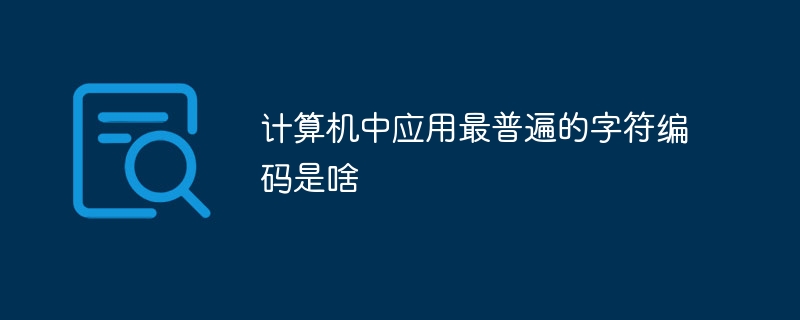
The most commonly used character encoding in computers is Unicode encoding. This is a character encoding standard defined and widely used by the International Organization for Standardization. It aims to provide unique identifiers for all known characters in the world. , whether you are inputting, editing and displaying text in the operating system, or browsing and communicating on the Internet, Unicode encoding can ensure the correct display and transmission of characters.

#The operating environment of this article: Windows 10 system, dell g3 computer.
In the development of computer technology, character encoding plays a vital role. Character encoding is a way of representing characters as binary numbers to facilitate correct recognition and processing by computers when processing and storing text data. Different character encoding schemes are widely used in different countries and regions, among which the most common character encoding is Unicode encoding.
Unicode encoding is a character encoding standard defined and widely used by the International Organization for Standardization (ISO). Unicode aims to provide a unique identifier for all known characters in the world, whether it is letters, numbers, punctuation marks, or special characters. This means that Unicode encoding can contain characters from Latin letters, Greek letters, Cyrillic letters, etc. to Chinese characters, Japanese letters, Arabic numerals and other different languages and symbols.
Unicode encoding uses a unified encoding table, called the Unicode character set or Unicode code point. This encoding table contains millions of code points, each code point corresponding to a unique Unicode character. Unicode characters can be represented in hexadecimal, prefixed by "U", followed by the character's code point value. For example, the Unicode encoding for the letter A is U 0041.
Unicode encoding is not just an encoding scheme, it also defines algorithms for processing and converting character encodings. The most commonly used character encoding scheme is UTF-8 (Unicode Transformation Format - 8-bit). UTF-8 is a variable-length encoding that converts Unicode encoding into a series of bytes for storage and transmission in computer systems. UTF-8 encoding is compatible with ASCII encoding, so for text containing only ASCII characters, UTF-8 encoding and ASCII encoding are exactly the same.
Due to the widespread application of Unicode encoding, people can use text in different languages on computers without having to consider character encoding issues. Whether you are entering, editing and displaying text in the operating system, or browsing and communicating on the Internet, Unicode encoding can ensure the correct display and transmission of characters.
In addition to Unicode encoding, there are some other character encoding schemes that are used in certain specific scenarios. For example, Chinese characters often use GBK (Guo Biao Kuai encoding) or GB2312 encoding. These encoding schemes are more efficient when processing Chinese characters because they only require one or two bytes to represent a Chinese character.
Although there are other character encoding schemes, Unicode encoding is still the most commonly used character encoding in computers. Unicode provides a unified character encoding standard that enables computers to process and display all languages and characters in the world. Whether in operating systems, programming languages or Internet applications, Unicode encoding plays an important role, providing people with convenient word processing and communication methods.
The above is the detailed content of What is the most commonly used character encoding in computers?. For more information, please follow other related articles on the PHP Chinese website!
 Computer Languages
Computer Languages
 Computer application areas
Computer application areas
 What is the encoding used inside a computer to process data and instructions?
What is the encoding used inside a computer to process data and instructions?
 The main reason why computers use binary
The main reason why computers use binary
 What are the main characteristics of computers?
What are the main characteristics of computers?
 What are the basic components of a computer?
What are the basic components of a computer?
 What keys do arrows refer to in computers?
What keys do arrows refer to in computers?
 How to recover browser history on computer
How to recover browser history on computer